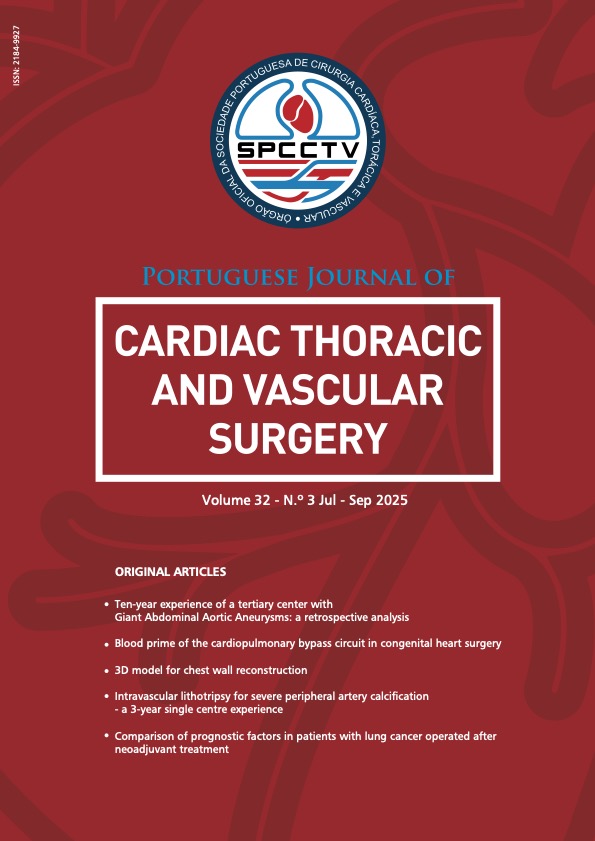Ten-Year Experience of a Tertiary Center with Giant Abdominal Aortic Aneurysms: A Retrospective Analysis
DOI:
https://doi.org/10.48729/pjctvs.529Keywords:
Abdominal Aortic Aneurysms management, Long-term outcomes, Surgical interventionAbstract
Introduction: The risk of rupture for abdominal aortic aneurysms (AAAs) is primarily influenced by their diameter with the likelihood of rupture increasing exponentially as the aneurysm enlarges. Nowadays, giant AAAs are relatively rare in clinical practice due to earlier diagnosis and treatment. This study aimed to analyze the treatment and prognosis of giant aneurysms comparing with non-giant AAAs within our center´s prospective registry.
Methods: We identified all AAAs treated at our center exceeding 9 cm in diameter from surgical records between January 1, 2013, and September 10, 2024. Demographic data, risk factors, anatomical characteristics, treatments, and outcomes were recorded. Furthermore, we analyzed and compared the anatomical features and outcomes of giant aneurysms with non-giant AAAs treated in our department (non-giant AAAs) from 2019 and 2023.
Results: A total of 24 patients with giant AAAs were identified, with a mean age of 77 .46±9.03 years, and the majority were male (95.8%). Rupture was significantly more frequent in the giant AAAs cohort (54.2% vs. 9.6%, p<0.001). Additionally, Giant AAAs were significantly less likely to undergo endovascular aneurysm repair (EVAR) (33.33% vs. 75.53%, p < 0.001), but with a higher risk of reintervention due to complications at 30 days (18.18% vs. 1.18%, p < 0.001) and 1 year (18.18% vs. 3.53%, p < 0.001) in non-ruptured sub-group.
Conclusion: Giant AAAs are predominantly ruptured at presentation and primarily managed with open surgical repair. When treated with EVAR, there was a higher risk of reintervention compared to non-giant AAAs.
Downloads
References
Buksh MM, Nuzhath S, Heslop J, Moawad M. A systematic review and case presentation: Giant abdominal aortic aneurysm. Vascular. 2024;32(3):521-32.
Wanhainen A, Van Herzeele J, Bastos Goncalves F, Bellmunt Montoya S, Berard X, Boyle JR, et al. Editor’s Choice – European Society for Vascular Surgery (ESVS) 2024 Clinical Practice Guidelines on the Management of Abdominal Aorto-iliac Artery Aneurysms. Eur J Vasc Endovasc Surg. 2024;67(2):192-331.
Leclerle FA, Johnson GR, Wilson SE, Chute EP, Hye RJ, Makaroun MS, et al. The aneurysm detection and management study screening program: validation cohort and final results. Aneurysm Detection and Management Veterans Affairs Cooperative Study Investigators. Arch Intern Med. 2000;160(10):1425-30.
Ullery BW, Itoga NK, Lee JT. Giant Abdominal Aortic Aneurysms: A Case Series and Review of the Literature. Vasc Endovascular Surg. 2015;49(8):242-6.
Ng JJ, Nguyen T, Tarpara A, Salvatore D, DiMuzio P, Abai B. Giant abdominal aortic aneurysms. J Vasc Surg Cases Innov Tech. 2021;7(4):659-64.
Droz NM, Miner J, Recchioni L. An 18-cm unruptured abdominal aortic aneurysm. J Vasc Surg Cases Innov Tech. 2017;3(1):16-9.
Maras D, Lloupis C, Moulakakis KG, Sfyrocras G, Pavlidis P, Bourutouris I, et al. Giant abdominal aortic aneurysms: clinical and technical considerations. Acta Chir Belg. 2009;109(3):376-80.
Bradbury AW, Makhdoomi KR, Adam DJ, Murie JA, Jenkins AM, Ruckley CV. Twelve-year experience of the management of ruptured abdominal aortic aneurysm. Br J Surg. 1997;84(12):1705-7.
Johnston KW. Ruptured abdominal aortic aneurysm: six-year follow-up results of a multicenter prospective study. Canadian Society for Vascular Surgery Aneurysm Study Group. J Vasc Surg. 1994;19(5):888-900.
Duijzer C, Schuurs TC, Wisselink W, Giant, 20 cm Diameter, Ruptured Abdominal Aortic Aneurysm: A Case Report. EIVES Short Rep. 2019;42:18-20.
Fillinger MF, Marra SP, Raghavan ML, Kennedy FE. Prediction of rupture risk in abdominal aortic aneurysm during observation: wall stress versus diameter. J Vasc Surg. 2003;37(4):724-32.
Venkatasubramaniam AK, Fagan MJ, Mehta T, Mylankal KJ, Ray B, Kuhan G, et al. A comparative study of aortic wall stress using finite element analysis for ruptured and non-ruptured abdominal aortic aneurysms. Eur J Vasc Endovasc Surg. 2004;28(2):168-76.
Vorp DA, Raghavan ML, Webster MW. Mechanical wall stress in abdominal aortic aneurysm: influence of diameter and asymmetry. J Vasc Surg. 1998;27(4):632-9.
Cronenwett JL, Murphy TF, Zelenock GB, Whitehouse WM, Jr., Lindenaier SM, Graham LM, et al. Actuarial analysis of variables associated with rupture of small abdominal aortic aneurysms. Surgery. 1985;98(3):472-83.
Katz DJ, Stanley JC, Zelenock GB. Gender differences in abdominal aortic aneurysm prevalence, treatment, and outcome. J Vasc Surg. 1997;25(3):561-8.
Laser A, Ghosh A, Roelofs K, Sadiq O, McEvoy B, DiMusto P, et al. Increased estrogen receptor alpha in experimental aortic aneurysms in females compared with males. J Surg Res. 2014;186(1):467-74.
Volpe P, Massara M, Alberti A, Marino S, Volpe A, Mazzaccaro D, et al. Preliminary Results of Aortic Stent Graft to Treat Infrarenal Abdominal Aortic Aneurysms with Severe Proximal Aortic Neck Angulation. Ann Vasc Surg. 2017;45:193-8.
Hwang D, Kim J, Kim HK, Huh S. Suitability of the Aortic Neck Anatomy for Endovascular Aneurysm Repair in Korean Patients with Abdominal Aortic Aneurysm. Vasc Specialist Int. 2020;36(2):71-81.
Peppelenbosch N, Ruth J, Harris PL, van Marrewijk C, Fransen G. Diameter of abdominal aortic aneurysm and outcome of endovascular aneurysm repair: does size matter? A report from EUROSTAR. J Vasc Surg. 2004;39(2):288-97.
Downloads
Published
How to Cite
License
Copyright (c) 2025 Portuguese Journal of Cardiac Thoracic and Vascular Surgery

This work is licensed under a Creative Commons Attribution 4.0 International License.





